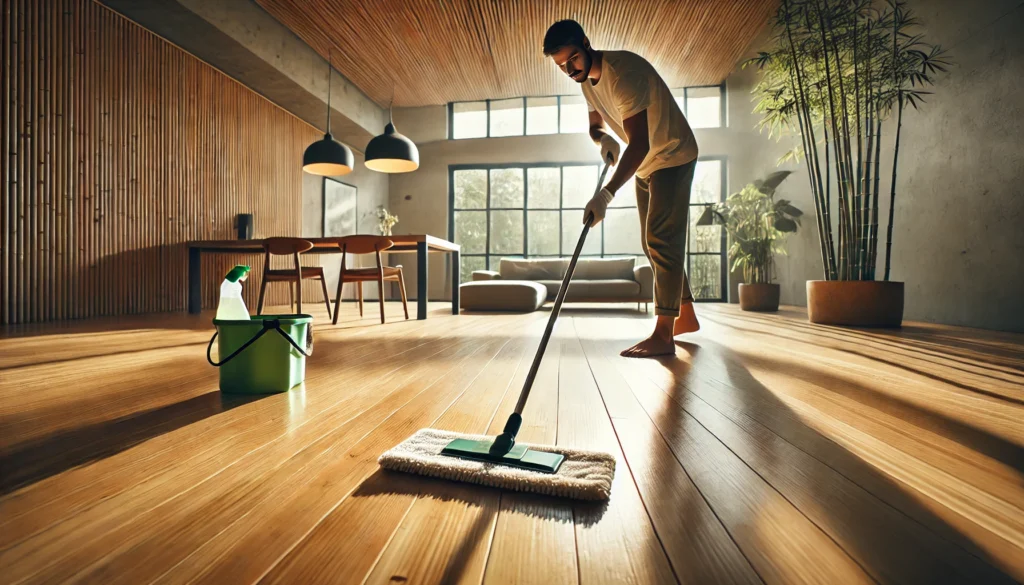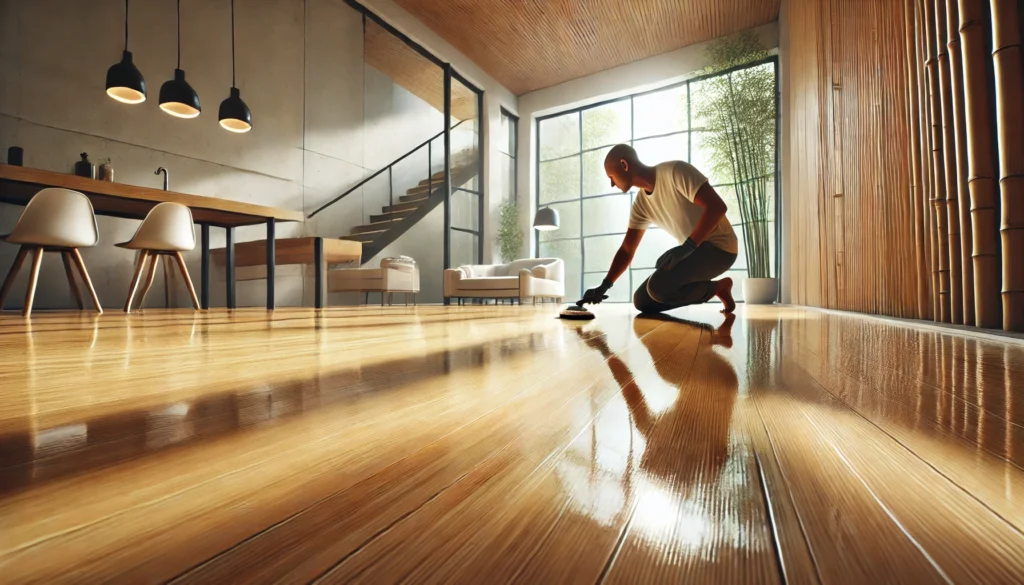
Imagine walking barefoot on a smooth, pristine bamboo floor that shines with a subtle glow, giving your home a sophisticated, natural touch. Bamboo floors are incredibly popular for their eco-friendliness, durability, and unique style. But maintaining that polished look can be a challenge if you’re unsure of the right cleaning methods.
Whether it’s sticky spills, pet tracks, or just everyday dust, bamboo floors can lose their shine if they’re not cared for properly. Cleaning bamboo floors isn’t as simple as grabbing the nearest cleaner and mop – using the wrong products or techniques can dull the finish or even damage the floor. If you’re wondering how to clean bamboo floors the right way, you’re in the right place. This guide will walk you through a foolproof process for safely and effectively maintaining your bamboo floors.
Why This Guide Will Transform Your Floor-Cleaning Routine
By following this guide, you’ll not only preserve the look and longevity of your bamboo floors but also save time and avoid costly mistakes. We’ll cover easy-to-follow steps, from daily maintenance to deep-cleaning methods. Plus, we’ll sprinkle in pro tips, troubleshooting advice, and frequently asked questions to ensure your cleaning routine leaves your floors looking brand-new.
Ready to bring back the shine to your bamboo floors? Let’s dive in!
Step-by-Step Instructions for Cleaning Bamboo Floors
Step 1: Gather the Right Tools and Supplies
What to Do: Start by assembling the cleaning essentials you’ll need.
How to Do It: For bamboo floors, opt for a soft-bristle broom, a vacuum with a hardwood floor setting, a microfiber mop, and a gentle, bamboo-safe floor cleaner. Avoid harsh chemicals, abrasive tools, or traditional mops that require a lot of water, as bamboo can be sensitive to excessive moisture and rough treatment.
Why It Matters: Using the right tools prevents scratches and ensures you don’t accidentally damage the bamboo. A microfiber mop or a soft-bristle broom is gentle on the surface, while a specialized bamboo floor cleaner won’t strip away any protective finish.
Pro Tip: Always check the cleaner’s label to ensure it’s safe for bamboo floors. When in doubt, opt for a mild, pH-neutral cleaner.
Step 2: Dust or Sweep Regularly
What to Do: Dust or sweep your bamboo floors daily or at least every other day.
How to Do It: Use a soft-bristle broom or a vacuum with a hardwood setting to remove dirt, dust, and debris. Sweep gently in the direction of the bamboo grain to ensure that any particles caught between the planks are swept out without scratching the surface.
Why It Matters: Dirt and small particles act like sandpaper on your floor’s finish. Regularly removing them prevents scratches and extends the life of your bamboo floors.
Pro Tip: If you’re vacuuming, avoid using a beater bar attachment, as it can leave marks on your bamboo floors. Stick with a hard floor setting instead.
Step 3: Mop with a Damp (Not Wet) Microfiber Mop
What to Do: When your floors need a deeper clean, use a damp microfiber mop.
How to Do It: Lightly mist your microfiber mop with water or a bamboo-safe floor cleaner. Be careful not to soak the mop; a damp mop is all you need. Mop in small sections, following the grain of the bamboo, and dry each section immediately with a soft cloth.
Why It Matters: Excessive water can seep into the seams of bamboo floors, causing them to warp or swell over time. A damp mop is effective without introducing too much moisture.
Pro Tip: For stubborn spots, apply a small amount of cleaner directly on the area, then gently scrub with a soft cloth. Avoid applying pressure to prevent any damage to the finish.
Step 4: Remove Stains and Spills Immediately
What to Do: Act quickly to wipe up any spills or stains.
How to Do It: Use a soft cloth or paper towel to blot spills. Avoid rubbing, as this can push the liquid deeper into the floor. For sticky or stubborn spills, dampen the cloth with a bit of floor cleaner and gently dab the area.
Why It Matters: Bamboo is slightly porous, meaning it can absorb liquids if left to sit. Quick clean-up prevents stains and avoids potential water damage.
Pro Tip: For oil or grease-based spills, a dab of mild dish soap on a damp cloth can help. Be sure to wipe the area with a clean, damp cloth afterward to remove any soap residue.
Step 5: Polish Bamboo Floors to Restore Shine
What to Do: Occasionally polish your floors to keep them looking glossy and fresh.
How to Do It: Use a bamboo-specific polish or a floor polish that’s safe for hardwoods. Apply it sparingly with a microfiber cloth, rubbing in small, circular motions. Be careful to follow the manufacturer’s instructions on frequency, as over-polishing can lead to a buildup that makes floors appear dull.
Why It Matters: Over time, bamboo floors may lose some of their luster. Polishing can revive their shine and protect them from scratches.
Pro Tip: Avoid using wax or oil-based polishes, as these can create a slippery surface or attract dust.

Step 6: Prevent Damage with Area Rugs and Furniture Pads
What to Do: Protect high-traffic areas and furniture contact points.
How to Do It: Place area rugs in spots that see a lot of foot traffic, such as entryways or hallways. Use furniture pads under chairs, tables, and other pieces to prevent scratches when they’re moved.
Why It Matters: Area rugs catch dirt before it gets ground into the floor, while furniture pads prevent scratches that can occur when furniture is accidentally dragged.
Pro Tip: Make sure the rug backing is non-abrasive, as some materials can scratch bamboo. Felt pads are a good choice for furniture, as they’re gentle yet durable.
Read more: How to Clean Bamboo Floors: A Comprehensive Guide
Troubleshooting & Additional Tips
Common Issues & Fixes
- Problem: Floor looks dull even after cleaning.
- Solution: This may be due to a buildup of cleaner or polish. To remove it, damp-mop with water and a bit of white vinegar (in a ratio of 1:4).
- Problem: Sticky residue left after mopping.
- Solution: Use less cleaner next time, and make sure you’re drying each section as you go. You can also try a plain water rinse to remove any lingering residue.
Best Practices & Tips for Long-Lasting Bamboo Floors
- Avoid walking on bamboo floors with high heels, which can dent the surface.
- Keep pet nails trimmed to prevent scratching.
- Use blinds or curtains to protect floors from direct sunlight, which can cause fading.
- Don’t use steam cleaners, as the high heat and moisture can damage the bamboo.
Frequently Asked Questions
1. How often should I clean my bamboo floors?
Dust or sweep them daily and mop once a week for routine maintenance. Polish or deep clean once every few months.
2. Can I use a steam mop on bamboo floors?
No, steam can damage bamboo by causing it to warp or swell. Stick to a damp microfiber mop instead.
3. What’s the best cleaner for bamboo floors?
A pH-neutral, bamboo-safe cleaner is ideal. Avoid any cleaner that contains ammonia or vinegar as a main ingredient.
4. How do I remove scratches from bamboo floors?
Minor scratches can often be hidden with a bamboo-friendly polish. For deeper scratches, you may need to consult a professional.
5. Is it okay to vacuum bamboo floors?
Yes, but only with a vacuum that has a hard floor setting or a soft attachment. Avoid the beater bar, as it can scratch the floor.
6. Can bamboo floors get wet?
They can handle small amounts of water, but avoid excessive moisture as it can damage bamboo. Clean up spills immediately and never soak the floor.
Conclusion
Keeping your bamboo floors clean and beautiful doesn’t have to be complicated. With the right tools, a regular cleaning schedule, and a few protective measures, you can enjoy the timeless elegance of bamboo flooring for years to come. Remember, the key is gentle, consistent care – a little daily dusting and a quick mop each week go a long way.
If you found this guide helpful, consider sharing it with others who might benefit from these tips. For more flooring care guides and home maintenance advice, check out our other articles!
